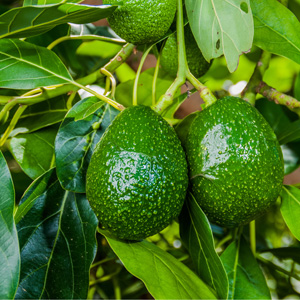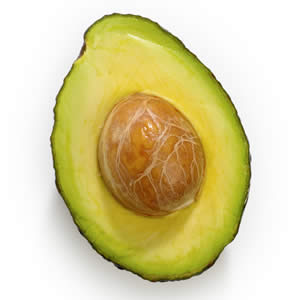Avocado Trees Growing Guide
The avocado tree (Persea americana) has transcended its origins from south-central Mexico to become a cherished part of gardens across the world. Known for its lush, evergreen foliage and highly nutritious fruit, the avocado is both a culinary staple and a delight to have in the garden.
Thriving in warm temperate to tropical climates, avocado trees can reach heights of 5–10 metres, with dwarf varieties also available for smaller spaces. These trees prefer a sunny position, sheltered from strong winds, in deep, well-drained soil. With proper care, even cold-tolerant varieties can survive temperatures down to about -5°C, broadening their appeal across different Australian regions.
From the popular ‘Hass’ to the small garden-friendly ‘Wurtz’, each avocado variety offers something unique to the grower. Whether you’re drawn to the avocado for its heart-healthy properties, the tropical aesthetic of its dark, glossy leaves, or the simple joy of harvesting your own fruit, growing an avocado tree can be a rewarding experience.
Benefits of Growing Avocado Trees
Whether it’s for the joy of harvesting your own fruit, or the enhancement of your garden’s look and feel, avocado trees offer something for every gardener. These beautiful trees bring a lush, vibrant look to any Australian garden, creating a cool, shaded oasis perfect for those hot summer days. Dwarf varieties cater to the urban Australian gardener, fitting into smaller spaces without compromising on the joy of harvesting fresh avocados.
How to Grow an Avocado Plant in Australia
Choosing the Right Variety for Your Region
Selecting an avocado variety that suits your local climate is crucial. ‘Hass’ is widely favoured for its year-round harvest in most warm temperate to subtropical areas. For cooler regions, ‘Wurtz’ varieties are an excellent choice due to their cold tolerance.
Site Preparation and Soil Conditions
Avocados require a sunny position, protected from strong winds, which can damage the tree and fruit. The soil needs to be deep, fertile, and well-drained to avoid waterlogging and root diseases. If dealing with clay soil, incorporate gypsum and organic matter to improve drainage and structure. In sloped areas, consider terracing or mounding to enhance water runoff and reduce erosion risk.
Planting Your Avocado Tree
The best time to plant avocado trees in Australia is during the early spring. Dig a hole twice as wide and as deep as the root ball of your tree. If planting a grafted tree, ensure the graft union is above the soil line to prevent rot. Water thoroughly after planting and mulch around the base with good quality organic matter, keeping it away from the trunk to prevent collar rot.
Watering and Fertiliser
Regular watering is essential for young trees, especially during their first summer. Reduce watering frequency as the tree establishes, but ensure deep watering during dry spells. Avocados benefit from fertiliser with a balanced, controlled-release formula designed for fruit trees. In sandy soils or for trees showing signs of nutrient deficiency, additional water-soluble fertiliser may be beneficial.
Ongoing Avocado Plant Care in Australia
Watering Needs
Once established, trees still require watering, but with a focus on occasional deep watering that reaches the roots rather than frequent shallow sprinkles. During extended dry periods, additional water may be necessary to prevent stress, which can lead to dropped fruit or poor development.
Mulching and Soil Health
Applying organic mulch around your avocado tree helps retain soil moisture, suppress weeds, and gradually improve soil structure as it decomposes. Keep the mulch a few centimetres away from the trunk to avoid moisture buildup against the bark. Refresh the mulch layer annually, and consider incorporating compost to boost soil and structure.
Fertilise
Avocado trees in Australia benefit from regular feeding with a fertiliser formulated for fruit trees, which should be applied in early spring and late summer. Look for fertilisers that include NPK (Nitrogen, Phosphorus, Potassium) but also essential micronutrients like zinc and boron, which are crucial for the health and productivity of avocado trees.
Pest and Disease Management
Keep an eye out for common pests such as bugs, mites, and scale, which can be managed with horticultural oils or specific organic pesticides safe for use on edible plants. Root rot, caused by poor drainage and overwatering, is a significant concern. Ensure good drainage at planting and consider rootstock resistant to Phytophthora root rot for added protection.
Pruning and Maintenance
Pruning in the early years should focus on shaping the tree and encouraging a strong, open structure that allows light into the canopy. As the tree matures, prune to remove dead or diseased wood and to manage the tree’s size. Be mindful of the tree’s flowering pattern, as excessive pruning can reduce flowering and fruit set. Remember, avocados fruit on the current or previous year’s growth, so judicious pruning is key to avoid reducing yield.
Challenges in Growing Avocados in Australia
Dealing with Climate Extremes
In Australia’s varied climate, avocados can face challenges from both frost in cooler regions and intense heat in warmer areas. To protect against frost, use frost cloth or consider installing a temporary windbreak or shade cloth structure. During heatwaves, ensure your avocado receives plenty of water, and consider using a light-coloured mulch to reflect heat away from the soil surface.
Improving Fruit Set and Yield
Avocados have a flowering pattern influenced by temperature, particularly cold conditions, which can impact fruit set. The flowers open twice over two days — first as female for about half a day, then as male the next day. This reduces the likelihood of self-pollination, especially in cooler climates.
For better yield, it’s recommended to plant two different types of avocado trees (type A and type B) to improve cross-pollination. Type A varieties, such as ‘Hass’, open as female in the morning, while type B varieties, like ‘Fuerte‘, open as female in the afternoon, increasing the chances of successful pollination.
In urban gardens with limited space, consider a grafted tree combining both types or encourage natural pollinators, like bees, by planting a variety of flowering plants nearby.
Avocado Flower Opening Sequence
| Flower type | Day 1
Morning |
Day 1
Afternoon |
Day 2
Morning |
Day 2
Afternoon |
| A | female | closed | closed | male |
| B | closed | female | male | closed |
Harvesting Tips
Avocados do not ripen on the tree and should be harvested when mature but still firm. A simple test is to remove a fruit and store it at room temperature; it should ripen within one to two weeks. If it remains hard or shrivels, allow the remaining fruit more time on the tree.
Final Tips for Growing Avocados in Australia

Patience Pays Off
Remember, growing avocados is a long-term commitment. Grafted trees accelerate the journey to your first harvest but still require several years to mature. Patience, coupled with consistent care, will ultimately reward you with a bounty of fruit.
Choose the Right Tree
It’s best to start with a healthy grafted avocado tree from a reputable nursery like Garden Express, focusing on varieties suited to your local climate. Consider your garden’s space and whether you’ll plant in the ground or a container, adjusting your choice accordingly.
Embrace Organic Practices
Incorporating organic gardening practices not only benefits your avocado tree but also supports the surrounding environment. From organic mulches to natural pest control, these methods promote a healthy, sustainable garden ecosystem.
Water Wisely
Over-watering is as harmful as under-watering. Establish a regular watering schedule that accounts for seasonal changes, especially during Australia’s hot summers. Deep, infrequent watering encourages strong root development.
Monitor and Maintain
Regularly inspect your tree for signs of pests, diseases, or nutrient deficiencies. Early detection and treatment can prevent minor issues from becoming major problems. Adjust care practices as your tree grows and seasons change.
Celebrate Each Milestone
From the first bloom to the initial harvest, each step in your avocado tree’s life is an achievement. Celebrate these milestones and share the journey with family and friends.
Avocados at Garden Express
Growing avocados in Australia can be a deeply rewarding endeavour that enhances your garden and kitchen. With the right care, attention to detail, and a bit of patience, you can enjoy the fruits of your labour for years to come. Garden Express stock a fantastic range of avocado plants ready for you to start your avocado tree journey.
Frequently Asked Questions on Growing Avocados in Australia
-
How long does it take for an avocado tree to bear fruit?
Grafted trees, which are recommended for quicker fruit production, typically begin to bear fruit within 4-5 years of planting. Trees grown from seed may take up to 10 years and may not produce fruit true to the parent variety.
-
Can I grow an avocado tree in a pot?
Yes, dwarf varieties are well-suited for pot cultivation in Australia, making it possible to grow avocados even in smaller urban gardens.
-
What varieties do Garden Express stock?
Garden Express currently stock:
-
What climate is best for growing avocados?
Avocados thrive in warm temperate, subtropical, and tropical regions of Australia. Some varieties are cold-tolerant to about -5°C, suitable for cooler climates as long as frost protection is provided.
-
How do I protect my avocado tree from frost?
In cooler regions, use frost cloth to wrap young trees or provide a structure that shields them from direct frost exposure. Ensuring adequate water and nutrition can also enhance cold tolerance.
-
Are there avocado varieties that grow well in Australia?
Several varieties are suited to Australian climates, including Hass for its creamy texture and year-round harvesting, and Reed for larger fruit. Wurtz are notable for their cold tolerance and suitability for cooler areas.
-
Do avocado trees need a pollination partner?
While avocados are self-fertile, having a companion tree of a different variety can significantly increase fruit set and yield, especially in warmer Australian regions.
-
How big do avocado trees get?
Standard avocado trees can grow up to 10 metres tall. However, for smaller spaces, dwarf varieties reach about 4 metres and can be pruned to maintain a manageable size.








